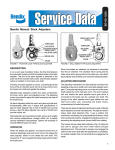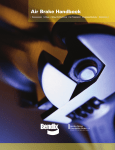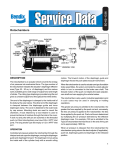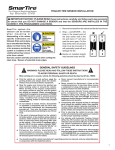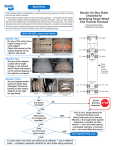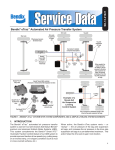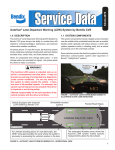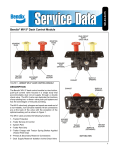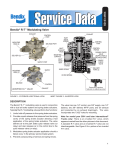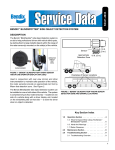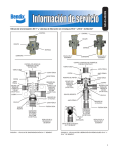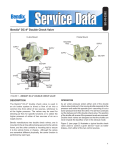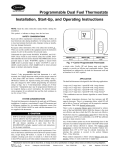Download BENDIX BW1426 User's Manual
Transcript
SD-02-1302 ® Bendix® Brake Chambers Different size brake chambers are identified by numbers which specify the effective area of the diaphragm. For example, a brake chamber that has 30 square inches of “effective area” (the area of the diaphragm that generates force on the push plate), is commonly referred to as a type 30 brake chamber. See Figure 2. Since one side of a brake chamber diaphragm is exposed to the applying air pressure and the other side to atmospheric pressure, the chamber has a pressure and a non‑pressure side. The non‑pressure plate is usually vented to atmosphere by vent holes. Installations where the chamber must be weather‑proof, venting is accomplished through a variety of methods. Consult the OEM for specific details. FIGURE 1 - BENDIX® BRAKE CHAMBER DESCRIPTION The brake chamber is a diaphragm-type actuator which converts the energy of air pressure into mechanical force. See Figure 2. The diaphragm is held between the pressure plate (A) and non-pressure plate (B) by either a one- or two-piece clamp ring (C). Side Inlet Port (shown plugged) The standard diaphragm material is a compound of natural rubber with a fabric interior of nylon. Neoprene‑nylon diaphragms are optionally available. OPERATION Controlled air pressure enters the brake chamber through the inlet port and acts upon the diaphragm moving the push plate and rod assembly forward. Vent Spring Non-Pressure Plate (B) Pressure Plate (A) Mounting Bolts Diaphragm Push Plate Push Plate and Push Rod Assy. Yoke Center Inlet Port Clamp Ring Nuts & Bolts Clamp Ring (C) Lock Nut FIGURE 2 - CUT-AWAY VIEW 1 GENERAL SAFETY GUIDELINES WARNING! PLEASE READ AND FOLLOW THESE INSTRUCTIONS TO AVOID PERSONAL INJURY OR DEATH: When working on or around a vehicle, the following guidelines should be observed AT ALL TIMES: ▲ Park the vehicle on a level surface, apply the parking brakes and always block the wheels. Always wear personal protection equipment. ▲ Stop the engine and remove the ignition key when working under or around the vehicle. When working in the engine compartment, the engine should be shut off and the ignition key should be removed. Where circumstances require that the engine be in operation, EXTREME CAUTION should be used to prevent personal injury resulting from contact with moving, rotating, leaking, heated or electrically-charged components. ▲ Do not attempt to install, remove, disassemble or assemble a component until you have read, and thoroughly understand, the recommended procedures. Use only the proper tools and observe all precautions pertaining to use of those tools. ▲ If the work is being performed on the vehicle’s air brake system, or any auxiliary pressurized air systems, make certain to drain the air pressure from all reservoirs before beginning ANY work on the vehicle. If the vehicle is equipped with a Bendix® AD-IS® air dryer system, a Bendix® DRM™ dryer reservoir module, or a Bendix® AD-9si™ air dryer, be sure to drain the purge reservoir. ▲ Following the vehicle manufacturer’s recommended procedures, deactivate the electrical system in a manner that safely removes all electrical power from the vehicle. ▲ Never exceed manufacturer’s recommended pressures. ▲ Never connect or disconnect a hose or line containing pressure; it may whip. Never remove a component or plug unless you are certain all system pressure has been depleted. ▲ Use only genuine Bendix® brand replacement parts, components and kits. Replacement hardware, tubing, hose, fittings, etc. must be of equivalent size, type and strength as original equipment and be designed specifically for such applications and systems. ▲ Components with stripped threads or damaged parts should be replaced rather than repaired. Do not attempt repairs requiring machining or welding unless specifically stated and approved by the vehicle and component manufacturer. ▲ Prior to returning the vehicle to service, make certain all components and systems are restored to their proper operating condition. ▲ For vehicles with Automatic Traction Control (ATC), the ATC function must be disabled (ATC indicator lamp should be ON) prior to performing any vehicle maintenance where one or more wheels on a drive axle are lifted off the ground and moving. ▲ The power MUST be temporarily disconnected from the radar sensor whenever any tests USING A DYNAMOMETER are conducted on a Bendix® Wingman® Advanced™-equipped vehicle. ▲ You should consult the vehicle manufacturer's operating and service manuals, and any related literature, in conjunction with the Guidelines above. 2 WARNING: Not all wheels and valve stems are compatible with Bendix Air Disc Brakes. Use only wheels and valve stems approved by the vehicle manufacturer to avoid the risk of valve stem shear and other compatibility issues. WARNING: AVOID CREATING DUST. POSSIBLE CANCER AND LUNG DISEASE HAZARD. While Bendix Spicer Foundation Brake LLC does not offer asbestos brake linings, the long-term affects of some non-asbestos fibers have not been determined. Current OSHA Regulations cover exposure levels to some components of non-asbestos linings, but not all. The following precautions must be used when handling these materials. ▲ Avoid creating dust. Compressed air or dry brushing must never be used for cleaning brake assemblies or the work area. ▲ Bendix recommends that workers doing brake work must take steps to minimize exposure to airborne brake lining particles. Proper procedures to reduce exposure include working in a well-ventilated area, segregation of areas where brake work is done, use of local filtered ventilation systems or use of enclosed cells with filtered vacuums. Respirators approved by the Mine Safety and Health Administration (MSHA) or National Institute for Occupational Safety and Health (NIOSH) should be worn at all times during brake servicing. ▲ Workers must wash before eating, drinking or smoking; shower after working, and should not wear work clothes home. Work clothes should be vacuumed and laundered separately without shaking. ▲ OSHA Regulations regarding testing, disposal of waste and methods of reducing exposure for asbestos are set forth in 29 Code of Federal Regulations §1910.001. These Regulations provide valuable information which can be utilized to reduce exposure to airborne particles. ▲ Material Safety Data Sheets on this product, as required by OSHA, are available from Bendix. Call 1-800-247-2725 and speak to the Tech Team or e-mail [email protected]. When the brake chamber is used to actuate cam-type foundation brake assemblies, the yoke is connected to a slack adjuster, which in turn is connected to the brake cam shaft. This forward motion of the push rod rotates the slack adjuster, and cam shaft, applying the vehicle brakes. CLAMP-RING TYPE BRAKE CHAMBER DATA (Dimensions in Inches) Effective Outside Max. Type Area Diameter* Stroke (Sq. In.) The greater the air pressure admitted to the brake chamber, the greater the force applied by the push rod. Conversely, the less pressure applied to the brake chamber, the less force will be applied by the push rod. Push rod force is determined by multiplying the delivered air pressure by the effective diaphragm area. For example, if 60 psi is admitted to a type 30 brake chamber, the lineal force on the end of the push rod is approximately 1800 lbs. 6 9 12 16 20 24 30 36 When air pressure is released from the brake chamber, the push rod return spring — in combination with the brake shoe return spring — returns the diaphragm, push plate and rod assembly, slack adjuster, and brake cam to their released positions, releasing the brakes. 6 9 12 16 20 24 30 36 4-1/2 5-1/4 5-11/16 6-3/8 6-25/32 7-7/32 8-3/32 9-5/16 1-5/8 1-3/4 1-3/4 2-1/4 2-1/4 2-1/4 2-1/2 3 FIGURE 3 - DIMENSION CHART A. Each month, every 8,000 miles or every 300 operating hours, depending on type of operation: B. LEAKAGE TEST 1. Check the push rod to slack adjuster alignment from release to the full stroke position to be sure the push rod moves out and returns properly without binding at the non‑pressure plate hole or with other structures. Also check the angle formed by the slack adjuster arm and push rod. It should be greater than 900 when the chamber is in the released position and approach 900 at maximum re‑adjustment stroke. Max. Stroke at Which Brakes Should Be Readjusted Should be as short as possible without brakes dragging 1-1/4 1-3/8 1-3/8 1-3/4 1-3/4 1-3/4 2 2-1/4 *Dimensions listed do not include capscrew head projections for rotochambers and bolt projections for clamp-type brake chambers. PREVENTIVE MAINTENANCE Max. Stroke With Brakes Adjusted 1. Make and hold a full brake application. 2. Using a soap solution, coat the clamping ring(s). If leakage is detected, tighten the clamping ring only enough to stop leakage. DO NOT OVERTIGHTEN as this can distort the sealing surface or clamping ring. Coat the area around the push rod hole (loosen the boot if necessary). No leakage is permitted. If leakage is detected, the diaphragm must be replaced. REMOVING AND INSTALLING 2. Check tightness of mounting nuts. Check cotter pins to make sure they are in place. 3. Check all hoses and lines. They should be secure and in good condition. 1.Block the vehicle wheels. 2.Release the air pressure in all reservoirs. B. Every year, or after each 100,000 miles/3600 operating hours, depending on the type of operation: 3.Disconnect the line to the chamber. 1. Disassemble and clean all parts. 4.Remove the yoke pin. 2. Install a new diaphragm or any other parts if they are worn or deteriorated. When the diaphragm, spring, or both are replaced, they should be replaced in the corresponding chamber on the same axle. 5.Remove the brake chamber. OPERATING AND LEAKAGE TESTS A. REMOVING B. INSTALLING 1. Mount the brake chamber to the mounting bracket. 2. Install the yoke (if removed) and yoke pin. 3. Check the angle formed by the centerline of the push rod and slack adjuster. Consult the slack adjuster manufacturer for proper installation angle(s). A. OPERATING TEST 1. Apply the brakes and observe the push rods move out promptly and without binding. 2. Release the brakes and observe that the push rods return to the released position promptly and without binding. 4. Connect the line to the chamber. Check to be sure that the hoses are properly supported and clamped, if necessary, to provide proper clearance. 5. Adjust the brakes to the slack adjuster manufacturer’s recommendations. 3 DIAPHRAGM REPLACEMENT AND DISASSEMBLY ASSEMBLY Clean the exterior of the brake chamber and mark the parts in relation to position to each other so that it may be assembled in the same way. 1. Stand the push rod assembly upright on a flat surface. CLAMP-RING TYPE CHAMBER NOTE: If the brake chamber is to be dismantled without removing the non‑pressure plate from the vehicle, slack adjuster should be backed‑off. CLAMP-RING TYPE CHAMBER 1. Pull out the push rod and clamp it at the non‑pressure plate. If using vise grip pliers, the push rod should be protected so that it will not be damaged. 2. Remove the clamp ring nuts and bolts. 3. If the chamber has a single clamp ring, spread the ring slightly, just enough to slip it off the plate. Care should be taken so that the clamp ring is not distorted. If the chamber uses a two-piece clamp ring, remove the clamp rings. 4. Remove the pressure plate and diaphragm. 5. Remove the yoke lock nut and yoke from the push rod and release the grip on the push rod, being careful to contain the push plate and non‑pressure plate until the return spring load is relaxed. 6. Remove the push rod assembly and spring. 2. Position the return spring on the push rod. 3. Install the boot or o‑ring on the non‑pressure plate (if applicable). 4. Position the non‑pressure plate on the push rod, and press the plate down against the tension of the spring until plate bottoms on flat surface. Clamp the rod with vise grips (protect the rod) at the plate. 5. If installing a single clamp ring, position the ring over the clamping surface of the non‑pressure plate. 6. Check the alignment marks (made before disassembly) and position the diaphragm in the pressure plate and place on the non-pressure plate. 7. If installing a single clamp ring, work the clamp ring over the clamping surface of the pressure plate and draw the clamp lugs together (with vise grips or a similar tool). Install the bolt and nut in the clamp and tighten, tapping with a soft-faced mallet (to center the clamp ring if necessary). Release the grip on the push rod and install the remaining bolt and nut. 8. Install the nuts and bolts evenly and only sufficiently to eliminate leakage. TESTING A BRAKE CHAMBER AFTER DIAPHRAGM REPLACEMENT 7. Remove the boot (if applicable). CLEANING AND INSPECTION 1. Clean all the metal parts in cleaning solvent, removing all rust and scale. All diaphragm sealing surfaces should be smooth and clean. Perform the tests outlined in the “Operating and Leakage Tests” section. 2. Carefully inspect all metal parts for cracks, distortion or damage. 3. Replace all rubber parts and all other parts not considered serviceable with Genuine Bendix® brand replacement parts. Log-on and Learn from the Best On-line training that's available when you are Visit www.brake-school.com. 4 24/7/365. BW1426 © 2014 Bendix Commercial Vehicle Systems LLC, a member of the Knorr-Bremse Group • 06/14 • All Rights Reserved.




